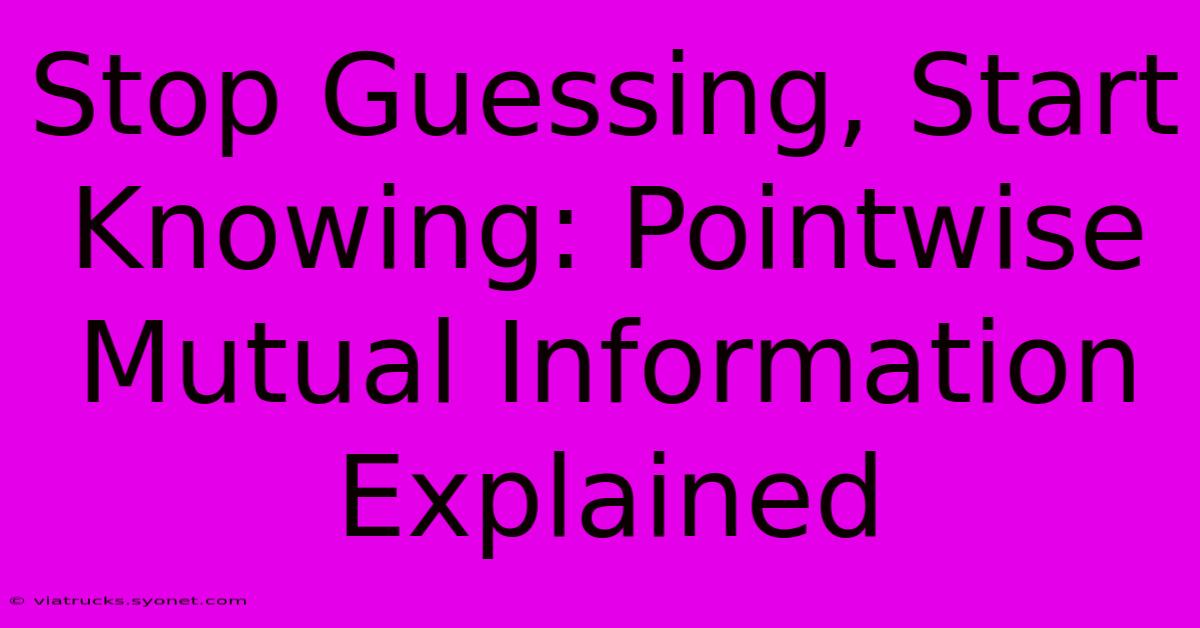Stop Guessing, Start Knowing: Pointwise Mutual Information Explained

Table of Contents
Stop Guessing, Start Knowing: Pointwise Mutual Information Explained
In the world of data analysis and machine learning, understanding the relationships between variables is paramount. While correlation coefficients offer a valuable measure of linear association, they fall short when dealing with more complex, non-linear relationships. This is where Pointwise Mutual Information (PMI) shines. PMI provides a powerful, flexible way to quantify the association between two events, regardless of their underlying distribution. This article will demystify PMI, exploring its calculation, interpretation, and applications.
What is Pointwise Mutual Information (PMI)?
Pointwise Mutual Information measures the mutual dependence between two events, x and y. In simpler terms, it quantifies how much knowing the occurrence of one event changes our knowledge about the occurrence of the other. A high PMI value indicates a strong association: the presence of one event significantly increases the likelihood of the other. Conversely, a low or negative PMI suggests a weak or inverse relationship.
PMI is defined mathematically as:
PMI(x, y) = log₂[P(x, y) / (P(x)P(y))]
Where:
- P(x, y): The joint probability of events x and y occurring together.
- P(x): The marginal probability of event x occurring.
- P(y): The marginal probability of event y occurring.
- log₂: The logarithm base 2, yielding a result in bits.
Understanding the Components of PMI
Let's break down the formula to better grasp its implications:
-
P(x, y): This represents the observed frequency of x and y occurring together, normalized by the total number of observations. A high joint probability signifies a frequent co-occurrence.
-
P(x)P(y): This represents the expected frequency of x and y occurring together if they were independent. If the events are independent, the joint probability is simply the product of their individual probabilities.
-
P(x, y) / (P(x)P(y)): This ratio compares the observed joint probability to the expected joint probability under independence. A ratio greater than 1 indicates a positive association (the events co-occur more often than expected), while a ratio less than 1 suggests a negative association (they co-occur less often than expected).
-
log₂: The logarithm transforms the ratio into a more interpretable scale, expressing the association in bits of information. A higher PMI value represents a stronger association.
Interpreting PMI Values
-
PMI > 0: Indicates a positive association between x and y. The events are more likely to co-occur than if they were independent.
-
PMI = 0: Indicates independence between x and y. The observed co-occurrence matches the expected co-occurrence under independence.
-
PMI < 0: Indicates a negative association between x and y. The events are less likely to co-occur than if they were independent.
Applications of Pointwise Mutual Information
PMI finds applications in various fields:
-
Natural Language Processing (NLP): Identifying word co-occurrences to build better language models, extract keywords, and perform topic modeling. For example, PMI can help determine strong collocations (word pairs that frequently appear together).
-
Information Retrieval: Improving search engine relevance by identifying terms that frequently co-occur in relevant documents.
-
Bioinformatics: Analyzing gene expression data to identify genes that are co-regulated.
-
Image Processing: Analyzing image features to understand relationships between different visual elements.
Limitations of PMI
While powerful, PMI has limitations:
-
Data Sparsity: With limited data, the probability estimates can be unreliable, leading to inaccurate PMI values. Smoothing techniques can mitigate this.
-
Sensitivity to Frequency: PMI can be heavily influenced by frequently occurring events, potentially overshadowing less frequent but potentially important relationships.
-
Computational Cost: Calculating PMI for large datasets can be computationally expensive.
Conclusion
Pointwise Mutual Information offers a robust and versatile method for quantifying the association between events, transcending the limitations of correlation measures. By understanding its calculation, interpretation, and limitations, you can effectively leverage PMI to gain deeper insights from your data and make more informed decisions. Remember to consider data sparsity and potential biases when interpreting PMI values, employing smoothing techniques and carefully considering the context of your analysis. Stop guessing; start knowing with the power of PMI.

Thank you for visiting our website wich cover about Stop Guessing, Start Knowing: Pointwise Mutual Information Explained. We hope the information provided has been useful to you. Feel free to contact us if you have any questions or need further assistance. See you next time and dont miss to bookmark.
Featured Posts
-
Kimberly Guilfoyle Life After Gavin Newsom And The California Governors Mansion
Feb 10, 2025
-
Paralympic Wheelchair Basketball A Story Of Resilience And Triumph
Feb 10, 2025
-
Gouiri Heros De L Om A Angers
Feb 10, 2025
-
From Campaigns To Cabinet Decoding The 46th Presidency
Feb 10, 2025
-
Jaguars Vs Eagles Stats Everything You Need To Know
Feb 10, 2025
